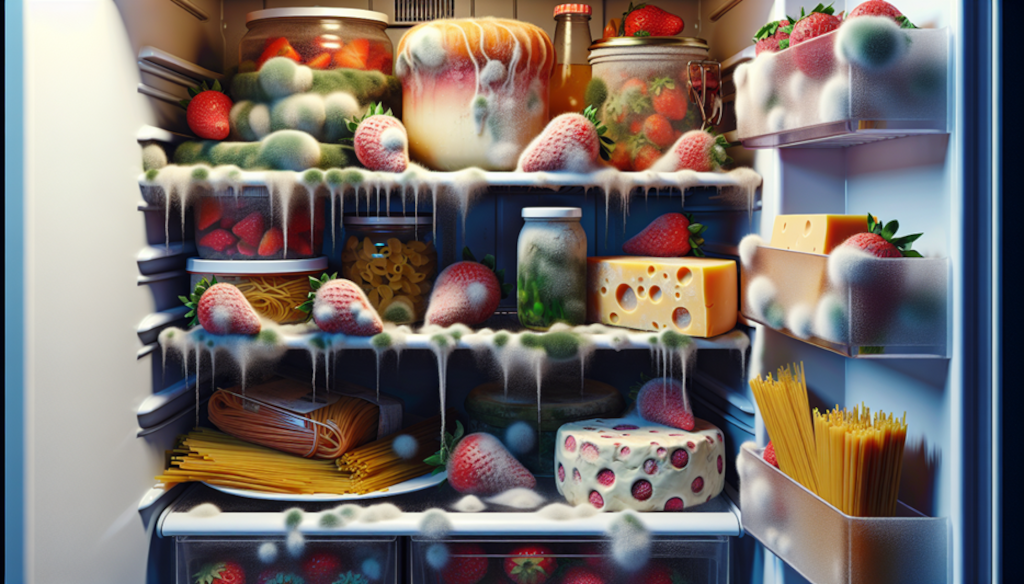Ever opened your fridge, excited for those fresh strawberries or leftover pasta, only to find them wearing a fuzzy white (or green, or black!) sweater?
It’s frustrating. You spend a lot of money on groceries. You store them properly—or so you thought. But still, mold shows up like an uninvited guest.
Here’s the surprising truth: Refrigerators don’t kill mold. In some cases, they help certain kinds thrive.
The unexpected mold enabler: Your fridge
I used to think the fridge was like a force field against spoilage. Cold = preservation, right?
Turns out, not exactly. While cool temps do slow down most microbial growth, mold is sneaky. Some species of mold enjoy cold, humid environments, and your fridge might be their vacation home.
That realization came when I found mold on a sealed block of cheese twice in the same month. That’s when I started digging deeper, and what I learned changed everything about how I store and care for food.
What makes mold grow in cold places?
Here’s the science in plain terms:
- Mold spores are everywhere: They float through the air, land on food and surfaces, and start growing when conditions are right.
- Fridges have moisture, especially if you open and close the door often, keep hot food inside, or stuff it full. Condensation builds up… and that’s free hydration for mold.
- Organic matter = food: Leftovers, fruits, dairy—mold loves them. High-moisture foods like berries, bread, and cheese mold faster than you think.
- Temperature swings help, bizarrely: If your fridge door doesn’t seal tightly or someone’s constantly opening it (teenagers, anyone?), the internal temperature shifts and creates little microclimates. Mold thrives on change.
Here’s a wild experiment example
In a 2015 university food safety course, a group of students conducted a simple fridge mold experiment. They tracked how long it took various foods to mold—cheddar cheese, strawberries, and cooked rice.
- Strawberries molded in 3 days, even when kept covered.
- The rice lasted a week but started molding once condensation formed inside the container.
- Cheddar lasted longest (12 days), but once blue mold appeared, it spread across half the block in just two days!
The most remarkable finding? Mold also grew faster in an older fridge where the temperature fluctuated more. That means your appliance might be sabotaging your groceries without you realizing it.
Simple shifts that make a big difference
Okay, so how do you fight invisible mold spores?
Here’s what actually works—no gimmicks, no overpriced fridge gadgets:
- Clean regularly: At least once a month. Wipe down all surfaces with white vinegar or baking soda solution.
- Keep food sealed: Use airtight containers, wrap produce, and always cover leftovers.
- Use it or lose it: If you won’t eat it within 3–5 days, freeze it. Mold doesn’t grow in the freezer.
- Inspect fridge seals: Your gasket should be airtight. A leaking seal = sneaky moisture + temp changes = mold paradise.
- Check the temp: Keep it between 35°F and 38°F (1.6°C to 3.3°C). Colder than 32°F and you freeze your lettuce; warmer than 40°F and bacteria/mold flourish.
But wait… mold might already be in your fridge
It’s true. Spores don’t just land on food—they stick to fridge walls, gaskets, drawer crevices. Especially after spills or spoiled produce.
If you’ve had moldy food in the past month, hit “reset” and do a deep clean ASAP. Think of it as evicting unwanted tenants from your fridge.
The takeaway: Mold is sneaky, but you’re smarter
You don’t have to accept spoiled food as a fact of life. Once you know how mold thinks—what it needs, where it hides—you can beat it at its own game.
Start with one thing: Clean out your fridge today. Toss anything questionable. Wipe it down. Set the temps right. Then, next time you grocery shop, you’ll have the upper hand.
Because nothing’s more annoying than craving strawberries—and finding them covered in fuzz.




Leave a Comment